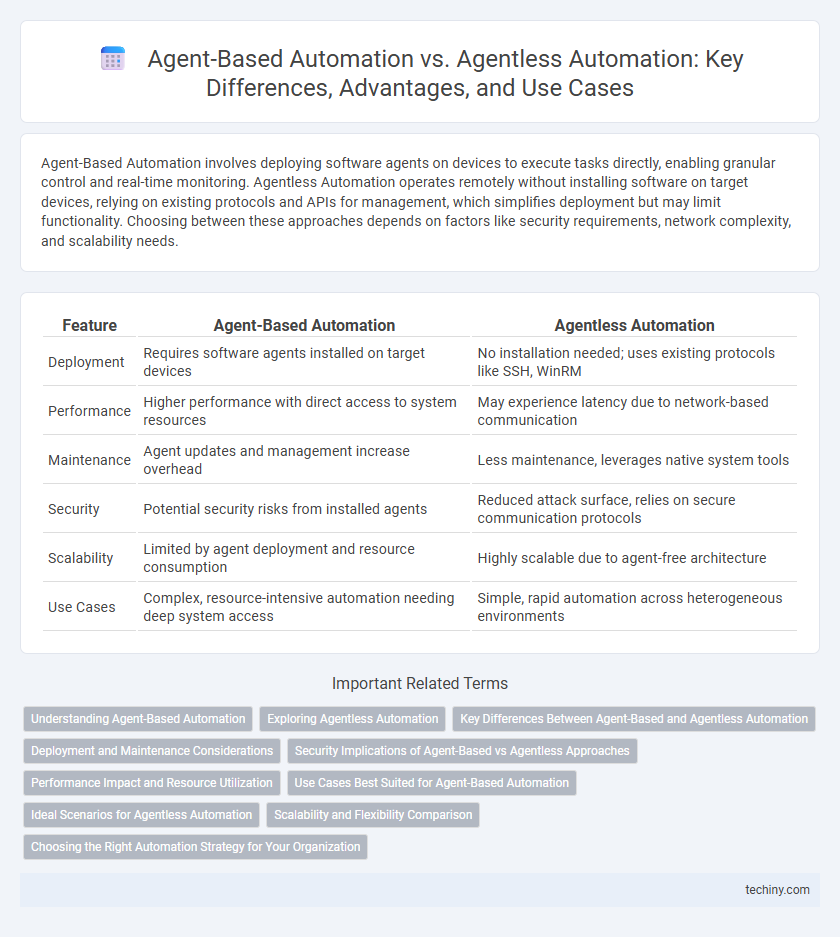Agent-Based Automation involves deploying software agents on devices to execute tasks directly, enabling granular control and real-time monitoring. Agentless Automation operates remotely without installing software on target devices, relying on existing protocols and APIs for management, which simplifies deployment but may limit functionality. Choosing between these approaches depends on factors like security requirements, network complexity, and scalability needs.
Table of Comparison
| Feature | Agent-Based Automation | Agentless Automation |
|---|---|---|
| Deployment | Requires software agents installed on target devices | No installation needed; uses existing protocols like SSH, WinRM |
| Performance | Higher performance with direct access to system resources | May experience latency due to network-based communication |
| Maintenance | Agent updates and management increase overhead | Less maintenance, leverages native system tools |
| Security | Potential security risks from installed agents | Reduced attack surface, relies on secure communication protocols |
| Scalability | Limited by agent deployment and resource consumption | Highly scalable due to agent-free architecture |
| Use Cases | Complex, resource-intensive automation needing deep system access | Simple, rapid automation across heterogeneous environments |
Understanding Agent-Based Automation
Agent-Based Automation relies on software agents installed on individual devices to execute tasks, enabling direct control and detailed monitoring of system activities. These agents facilitate real-time data collection and improved responsiveness, making them suitable for complex environments requiring granular management. Understanding the deployment and maintenance of agent-based solutions is essential for optimizing automation performance and security.
Exploring Agentless Automation
Agentless automation leverages pre-existing protocols and APIs to execute tasks without deploying software agents on target devices, minimizing resource consumption and simplifying maintenance. This approach enhances scalability and reduces security risks associated with agent installation and management. Enterprises increasingly adopt agentless automation to streamline IT workflows while preserving network integrity and compliance standards.
Key Differences Between Agent-Based and Agentless Automation
Agent-Based Automation relies on installed software agents on devices, enabling deeper data collection and granular control, whereas Agentless Automation operates remotely without requiring local installations, reducing deployment complexity. Agent-based systems provide real-time monitoring and enhanced security compliance through direct access, while agentless solutions offer greater scalability and faster setup by communicating over standard protocols like SSH or WMI. Performance impact and maintenance overhead are higher for agent-based automation due to continuous local resource consumption, contrasting with agentless automation's minimal footprint but potential limitations in detailed telemetry and control.
Deployment and Maintenance Considerations
Agent-based automation requires software installation on each target system, which can increase deployment time and necessitate ongoing maintenance for agent updates and compatibility. Agentless automation leverages existing protocols like SSH or API integration, reducing deployment complexity but potentially limiting deep system control and customization. Maintenance efforts vary, with agentless solutions minimizing agent-related overhead while relying heavily on network stability and security configurations.
Security Implications of Agent-Based vs Agentless Approaches
Agent-based automation injects software agents on each device, enabling deep visibility and granular control that enhance security monitoring and threat detection. Agentless automation reduces attack surfaces by minimizing software installations but may limit real-time data access and delay response times to security incidents. Evaluating security implications involves balancing comprehensive endpoint protection against potential vulnerabilities introduced by agents and the operational simplicity of agentless methods.
Performance Impact and Resource Utilization
Agent-Based Automation deploys software agents on target systems, which can increase resource usage and potentially impact performance due to continuous monitoring and data collection. Agentless Automation operates through remote protocols without installing agents, reducing resource consumption and minimizing performance impact on managed systems. Choosing between these approaches depends on balancing the need for detailed system insights against the importance of low overhead and scalability.
Use Cases Best Suited for Agent-Based Automation
Agent-based automation is ideal for environments requiring deep system integration, real-time monitoring, and complex task execution, such as endpoint security, software deployment, and configuration management. It excels in scenarios where continuous communication with the system is necessary for collecting detailed metrics and enforcing policies directly on devices. Enterprises leveraging agent-based automation benefit from enhanced control over system behavior, improved data accuracy, and the ability to perform tasks even when the network connection is intermittent.
Ideal Scenarios for Agentless Automation
Ideal scenarios for agentless automation include environments where rapid deployment and minimal infrastructure disruption are critical, such as cloud-based platforms, hybrid IT ecosystems, and large-scale data centers. Agentless automation excels in managing and orchestrating tasks across diverse systems without installing additional software, making it suitable for dynamic, heterogeneous networks requiring real-time monitoring and compliance checks. This approach reduces maintenance overhead and enhances security by minimizing direct access points on target machines.
Scalability and Flexibility Comparison
Agent-Based Automation involves deploying software agents on individual devices, enabling granular control and customized automation workflows but may face scalability challenges as the number of endpoints increases. Agentless Automation relies on remote management protocols, offering superior scalability by eliminating the need for local installations while providing flexibility through centralized control and easier updates. Scalability in agentless systems benefits large, dynamic environments, whereas agent-based solutions excel in complex, security-sensitive scenarios requiring detailed endpoint management.
Choosing the Right Automation Strategy for Your Organization
Agent-Based Automation relies on software agents installed on endpoints, offering precise control, detailed data collection, and customization for complex IT environments, while Agentless Automation operates without installing agents, facilitating faster deployment and easier scalability through remote management. Selecting the right automation strategy depends on factors like network size, security requirements, infrastructure complexity, and maintenance resources. Organizations with stringent security policies and diverse systems may benefit from agent-based solutions, whereas those prioritizing rapid implementation and minimal endpoint impact often prefer agentless automation.
Agent-Based Automation vs Agentless Automation Infographic

 techiny.com
techiny.com